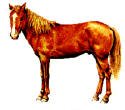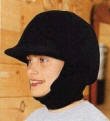|
Equine Kingdom Riding Academy
is no longer in operation. These more than 2,000 unique pages are provided for historical and educational reference. |
||
|
|
||
|
|
- Basuto - |
|
The Basuto is one of the most well-known pony breeds of South Africa, although it is not indigenous to the country. The Basuto achieved its fame during the 19th century as a warhorse. Although it is small in size, the Basuto is considered a small horse, because it possesses horse-like characteristics, such as an exceptionally long stride. The first horses arrived in South Africa in 1653, when four horses were introduced to the Cape area by the Dutch East India Trading Company. The exact breed of these horses is unknown, but they may quite likely have been Arabian and Persian. They were likely similar to the Java pony, and they were upgraded later with Arabian and Persian blood. These original imported horses became the founders of the Cape Horse, which became extremely popular and especially gained an admirable reputation during the Boer War. The Cape Horse and the Basuto probably were originally the same horse, and then with continual Thoroughbred and Arabian blood, the Cape Horse became a larger, more quality animal, with the Basuto remained smaller and stockier. Lesotho, formerly known as Basutoland, acquired the Cape Horse as a spoils of war between the Zulus and the settlers. As a result of harsh conditions and interbreeding with local ponies, the Cape Horse lost much of its height and nobility, and the Basuto pony largely took its place. Due to the rocky and hilly terrain that the Basuto ponies were continually ridden over, oftentimes at great speeds, they developed into tough, surefooted animals with incredible stamina and bravery. These excellent qualities were very nearly the undoing of the breed. The Basuto became so popular that thousands upon thousands of them were exported, and then many of the best horses were killed in action during the Boer War at the end of the 19th century. There is now a concerted effort to re-establish the commendable Basuto breed. Basuto ponies are often used for racing or polo now. These have a rather heavy head, a long neck and long, straight back, a straight shoulder, and a muscular, sloping croup. They usually have very tough legs and they have sound, incredibly hard hooves. They stand at any point up to 14.2 hands high, but are rarely any taller. They can be chestnut, brown, bay, or gray, and have white markings.
Ladies Leather Zip Paddock Boots Cozy Helmet Covers Vinyl Covered Hoof Pick
|










